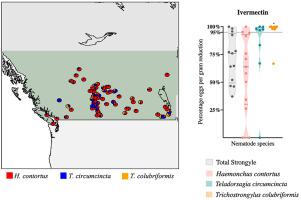International Journal for Parasitology: Drugs and Drug Resistance ( IF 4.1 ) Pub Date : 2020-09-19 , DOI: 10.1016/j.ijpddr.2020.09.003 Camila Queiroz 1 , Michel Levy 2 , Russell Avramenko 1 , Elizabeth Redman 1 , Kelsey Kearns 1 , Lana Swain 1 , Haley Silas 1 , Fabienne Uehlinger 3 , John S Gilleard 1

|
A lack of quantitative information on the species composition of parasite communities present in fecal samples is a major limiting factor for the sensitivity, accuracy and interpretation of the diagnostic tests commonly used to assess anthelmintic efficacy and resistance. In this paper, we investigate the ability of ITS-2 rDNA nemabiome metabarcoding to enhance fecal egg count reduction testing by providing information on the effect of drug treatments on individual parasite species. Application of ITS-2 rDNA nemabiome metabarcoding to fecal samples from ewes from over 90 flocks across western Canada revealed high gastrointestinal nematode infection intensities in many flocks with Haemonchus contortus being the most abundant species followed by Teladorsagia circumcincta and then Trichostrongylus colubriformis. Integration of ITS-2 rDNA nemabiome metabarcoding with pre- and post-treatment fecal egg counting revealed consistently poor efficacy of producer-applied ivermectin and benzimidazole treatments against H. contortus, but much better efficacy against T. circumcincta and T. colubriformis, except for in a small number of flocks. Integration of nemabiome ITS-2 rDNA metabarcoding with Fecal Egg Count Reduction Tests (FECRT), undertaken on farm visits, confirmed that ivermectin and fenbendazole resistance is widespread in H. contortus but is currently less common in T. circumcincta and T. colubriformis in western Canada. FECRT/nemabiome testing did not detect moxidectin resistance in any GIN species but suggested the early emergence of levamisole resistance specifically in T. circumcincta. It also revealed that although poor efficacy to closantel was relatively common, based on total fecal egg counts, this was due to its narrow spectrum of activity rather than the emergence of anthelmintic resistance. This study illustrates the value of ITS-2 rDNA nemabiome metabarcoding to improve fecal egg count resistance testing, perform large-scale anthelmintic resistance surveillance and direct more targeted rational anthelmintic use.
中文翻译:

使用 ITS-2 rDNA 线虫元条形码增强绵羊胃肠道线虫的抗蠕虫药耐药性诊断和监测
缺乏关于粪便样本中寄生虫群落物种组成的定量信息是通常用于评估驱虫药功效和抗药性的诊断测试的灵敏度、准确性和解释的主要限制因素。在本文中,我们通过提供有关药物治疗对单个寄生虫物种的影响的信息,研究了 ITS-2 rDNA 线状生物组元条形码增强粪便卵数减少测试的能力。ITS-2 rDNA的nemabiome metabarcoding从母羊粪便样品来自加拿大西部的90群应用在许多成群揭示高胃肠道线虫感染强度捻转血矛线虫是最丰富的物种其次Teladorsagia circumcincta然后毛圆线虫。将 ITS-2 rDNA 线虫元条形码与处理前和处理后的粪便卵计数相结合,表明生产者应用的伊维菌素和苯并咪唑治疗对H. contortus 的疗效一直很差,但对T. circlecincta和T. colubriformis 的疗效要好得多,除了在少数羊群中。nemabiome ITS-2的rDNA metabarcoding与粪蛋的累加计数减少测试(FECRT),农场进行访问,证实伊维菌素和芬苯达唑阻力是广泛存在于捻转血矛线虫,但目前还不常见于T. circumcincta和T.蛇形毛圆线虫在西部加拿大。FECRT/nemabiome 测试未检测到任何 GIN 物种中的莫昔克丁耐药性,但表明早期出现左旋咪唑耐药性,特别是在T. circlecincta 中。它还表明,尽管基于粪便卵总数,对 closantel 疗效不佳的情况相对普遍,但这是由于其活性谱窄,而不是出现抗蠕虫药。这项研究说明了 ITS-2 rDNA 线状生物组元条形码在改善粪便卵数抗性检测、进行大规模抗蠕虫抗药性监测和指导更有针对性的合理驱虫药使用方面的价值。











































 京公网安备 11010802027423号
京公网安备 11010802027423号